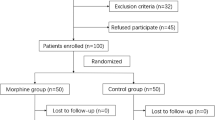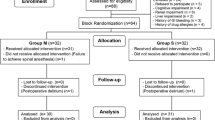Abstract
Background
Patient-controlled analgesia is a widely used and effective method of controlling pain after THA. This method is associated with substantial undesirable side effects. Local infiltration has been introduced in an attempt to reduce opioid requirements postoperatively, but its ability to reduce pain without complications is still questioned.
Questions/Purposes
We evaluated patient-controlled analgesia use, pain and satisfaction scores, complication rates, and ropivacaine levels associated with the use of periarticular multimodal drug infiltration in THA.
Patients and Methods
We randomized 64 patients undergoing THA to receive a periarticular intraoperative multimodal drug injection or to receive no injection. All patients received patient-controlled analgesia for 24 hours after surgery. The final assessment was at 6 weeks.
Results
Patients receiving the periarticular injection used less patient-controlled analgesia 6 hours postoperatively. The 24-hour patient-controlled analgesia requirement postsurgery also was less. The visual analog scale score for pain on activity in the postanesthetic care unit was less for patients who received an injection. The visual analog scale satisfaction score was similar in the two groups throughout the followup period. Recorded unbound ropivacaine levels were 2.5 times lower than toxic levels.
Conclusions
Periarticular intraoperative injection with multimodal drugs can reduce postoperative patient-controlled analgesia requirements and pain on activity in patients undergoing THA with no apparent increase in risk.
Level of Evidence
Level I, therapeutic study. See the guidelines online for a complete description of level of evidence.




Similar content being viewed by others
References
Andersen KV, Pfeiffer-Jensen M, Haraldsted V, Søballe K. Reduced hospital stay and narcotic consumption, and improved mobilization with local and intraarticular infiltration after hip arthroplasty: a randomized clinical trial of an intraarticular technique versus epidural infusion in 80 patients. Acta Orthop. 2007;78:180–186.
Asayama I, Kinsey TL, Mahoney OM. Two-year experience using a limited-incision direct lateral approach in total hip arthroplasty. J Arthroplasty. 2006;21:1083–1091.
Badner NH, Bourne RB, Rorabeck CH, MacDonald SJ, Doyle JA. Intra-articular injection of bupivacaine in knee-replacement operations: results of use for analgesia and for preemptive blockade. J Bone Joint Surg Am. 1996;78:734–738.
Berger RA, Jacobs JJ, Meneghini RM, Della Valle C, Paprosky W, Rosenberg AG. Rapid rehabilitation and recovery with minimally invasive total hip arthroplasty. Clin Orthop Relat Res. 2004;429:239–247.
Busch CA, Shore BJ, Bhandari R, Ganapathy S, MacDonald SJ, Bourne RB, Rorabeck CH, McCalden RW. Efficacy of periarticular multimodal drug injection in total knee arthroplasty: a randomized trial. J Bone Joint Surg Am. 2006;88:959–963.
Cashman JN. The mechanisms of action of NSAIDs in analgesia. Drugs. 1996;52(suppl 5):13–23.
Chang RW, Pellisier JM, Hazen GB. A cost-effectiveness analysis of total hip arthroplasty for osteoarthritis of the hip. JAMA. 1996;275:858–865.
Denson DD, Myers JA, Hartrick CT, Pither CP, Coyle DE, Raj PP. The relationship between free bupivacaine concentration and central nervous system toxicity. Anesthesiology. 1984;61:A211.
DeWeese FT, Akbari Z, Carline E. Pain control after knee arthroplasty: intraarticular versus epidural anesthesia. Clin Orthop Relat Res. 2001;392:226–231.
Frater RA, Moores MA, Parry P, Hanning CD. Analgesia-induced respiratory depression: comparison of meptazinol and morphine in the postoperative period. Br J Anaesth. 1989;63:260–265.
Gedney JA, Liu EH. Side-effects of epidural infusions of opioid bupivacaine mixtures. Anaesthesia. 1998;53:1148–1155.
Giuffre M, Asci J, Arnstein P, Wilkinson C. Postoperative joint replacement pain: description and opioid requirement. J Post Anesth Nurs. 1991;6:239–245.
Hallenbeck JL. Palliative Care Perspectives: Chapter 4: Pain Management: Conversion among Different Opioids. Copyright 2003 by Oxford University Press, New York, NY. Available at: http://www.mywhatever.com/cifwriter/library/70/4932.html. Accessed October 13, 2009.
Hebl JR, Kopp SL, Ali MH, Horlocker TT, Dilger JA, Lennon RL, Williams BA, Hanssen AD, Pagnano MW. A comprehensive anesthesia protocol that emphasizes peripheral nerve blockade for total knee and total hip arthroplasty. J Bone Joint Surg Am. 2005;87(suppl 2):63–70.
Indelli PF, Grant SA, Nielsen K, Vail TP. Regional anesthesia in hip surgery. Clin Orthop Relat Res. 2005;441:250–255.
Kerr DR, Kohan L. Local infiltration analgesia: a technique for the control of acute postoperative pain following knee and hip surgery: a case study of 325 patients. Acta Orthop. 2008;79:174–183.
Kiebzak GM, Vain PA, Gregory AM, Mokris JG, Mauerhan DR. SF-36 general health status survey to determine patient satisfaction at short-term follow-up after total hip and knee arthroplasty. J South Orthop Assoc. 1997;6:169–172.
Knudsen K, Beckman Suurkula M, Blomberg S, Sjovall J, Edvardsson N. Central nervous and cardiovascular effects of i.v. infusions of ropivacaine, bupivacaine and placebo in volunteers. Br J Anaesth. 1997;78:507–514.
Mahoney OM, Noble PC, Davidson J, Tullos HS. The effect of continuous epidural analgesia on postoperative pain, rehabilitation, and duration of hospitalization in total knee arthroplasty. Clin Orthop Relat Res. 1990;260:30–37.
Mauerhan DR, Campbell M, Miller JS, Mokris JG, Gregory A, Kiebzak GM. Intra-articular morphine and/or bupivacaine in the management of pain after total knee arthroplasty. J Arthroplasty. 1997;12:546–552.
McDonald S, Hetrick S, Green S. Pre-operative education for hip or knee replacement. Cochrane Database Syst Rev. 2004;1:CD003526.
McNeill JA, Sherwood GD, Starck PL, Thompson CJ. Assessing clinical outcomes: patient satisfaction with pain management. J Pain Symptom Manage. 1998;16:29–40.
Nikolajsen L, Brandsborg B, Lucht U, Jensen TS, Kehlet H. Chronic pain following total hip arthroplasty: a nationwide questionnaire study. Acta Anaesthesiol Scand. 2006;50:495–500.
Parvataneni HK, Shah VP, Howard H, Cole N, Ranawat AS, Ranawat CS. Controlling pain after total hip and knee arthroplasty using a multimodal protocol with local periarticular injections: a prospective randomized study. J Arthroplasty. 2007;22(6 suppl 2):33–38.
Peters CL, Shirley B, Erickson J. The effect of a new multimodal perioperative anesthetic regimen on postoperative pain, side effects, rehabilitation, and length of hospital stay after total joint arthroplasty. J Arthroplasty. 2006;21(6 suppl 2):132–138.
Pettine KA, Wedel DJ, Cabanela ME, Weeks JL. The use of epidural bupivacaine following total knee arthroplasty. Orthop Rev. 1989;18:894–901.
Pour AE, Parvizi J, Sharkey PF, Hozack WJ, Rothman RH. Minimally invasive hip arthroplasty: what role does patient preconditioning play? J Bone Joint Surg Am. 2007;89:1920–1927.
Ranawat AS, Ranawat CS. Pain management and accelerated rehabilitation for total hip and total knee arthroplasty. J Arthroplasty. 2007;22(7 suppl 3):12–15.
Röstlund T, Kehlet H. High-dose local infiltration analgesia after hip and knee replacement: what is it, why does it work, and what are the future challenges? Acta Orthop. 2007;78:159–161.
Solanki DR, Enneking FK, Ivey FM, Scarborough M, Johnston RV. Serum bupivacaine concentrations after intraarticular injection for pain relief after knee arthroscopy. Arthroscopy. 1992;8:44–47.
Stein C. Peripheral mechanisms of opioid analgesia. Anesth Analg. 1993;76:182–191.
Stein C. The control of pain in peripheral tissue by opioids. N Engl J Med. 1995;332:1685–1690.
Thomas T, Robinson C, Champion D, McKell M, Pell M. Prediction and assessment of the severity of post-operative pain and of satisfaction with management. Pain. 1998;75:177–185.
Vendittoli PA, Makinen P, Drolet P, Lavigne M, Fallaha M, Guertin MC, Varin F. A multimodal analgesia protocol for total knee arthroplasty: a randomized, controlled study. J Bone Joint Surg Am. 2006;88:282–289.
Weller R, Rosenblum M, Conard P, Gross JB. Comparison of epidural and patient-controlled intravenous morphine following joint replacement surgery. Can J Anaesth. 1991;38:582–586.
Acknowledgments
We acknowledge Dr. L. Kohan and Dr. D. Kerr of Sydney, Australia, for their work in developing the multimodal drug combination used in this study. We also thank Prof C. H. Rorabeck and Dr. R. Bhandari for contributions to work with this research and the previous investigation of multimodal drug infiltration in TKAs.
Author information
Authors and Affiliations
Corresponding author
Additional information
Each author certifies that he or she has no commercial associations (eg, consultancies, stock ownership, equity interest, patent/licensing arrangements, etc) that might pose a conflict of interest in connection with the submitted article.
Each author certifies that his or her institution approved the human protocol for this investigation, that all investigations were conducted in conformity with ethical principles of research, and that informed consent for participation in the study was obtained.
This work was performed at London Health Sciences Centre.
About this article
Cite this article
Busch, C.A., Whitehouse, M.R., Shore, B.J. et al. The Efficacy of Periarticular Multimodal Drug Infiltration in Total Hip Arthroplasty. Clin Orthop Relat Res 468, 2152–2159 (2010). https://doi.org/10.1007/s11999-009-1198-7
Received:
Accepted:
Published:
Issue Date:
DOI: https://doi.org/10.1007/s11999-009-1198-7




